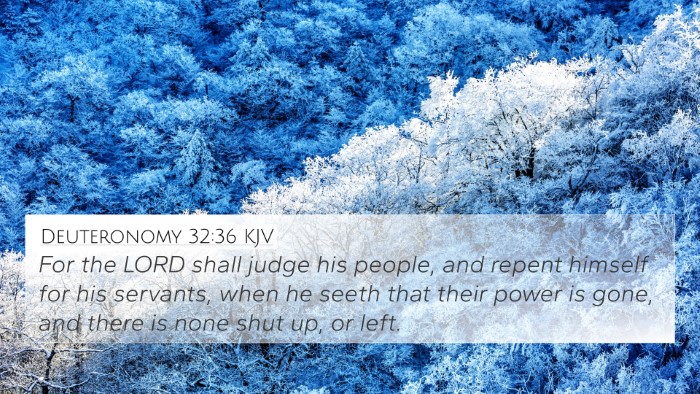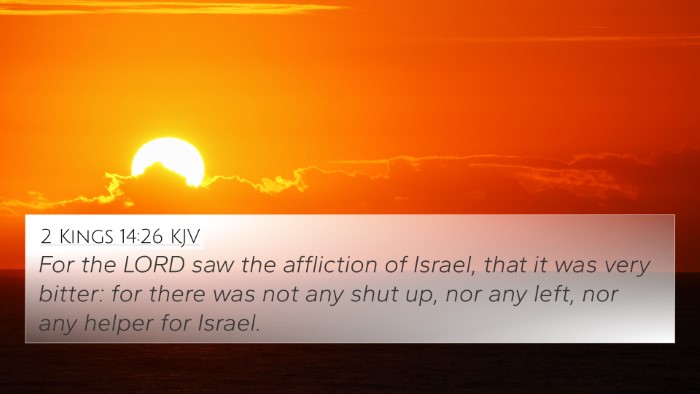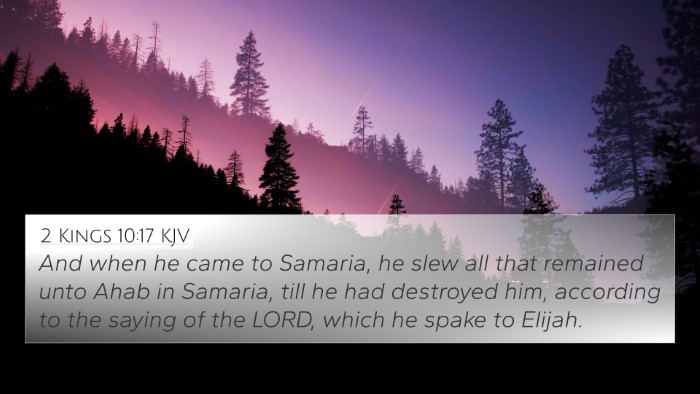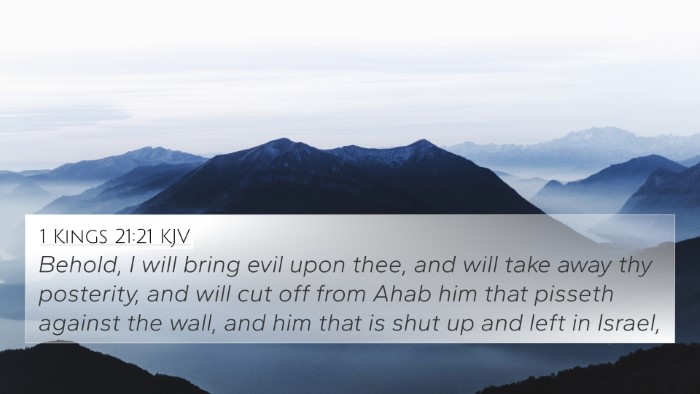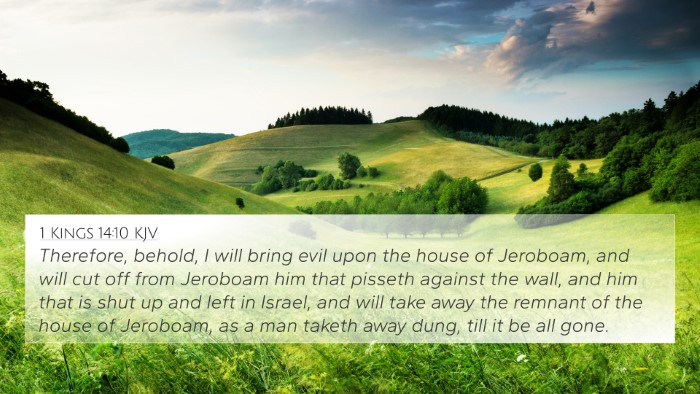Understanding 2 Kings 9:8
Verse: "And the whole house of Ahab shall perish; and I will cut off from Ahab him that pisseth against the wall, and him that is shut up and left in Israel." (2 Kings 9:8)
The verse speaks about the divine judgment pronounced against Ahab's lineage, illustrating God's justice and the consequences of unrighteousness. The language used is vivid and emphatic, signifying total destruction of Ahab’s household.
Verse Meaning and Interpretation
This verse signifies a pivotal moment in the Biblical narrative, marking God's intervention in the affairs of Israel, particularly in relation to Ahab’s idolatry and the bloodshed instigated by him and his family.
Key Interpretations from Commentaries:
-
Matthew Henry: He emphasizes that God's wrath is inevitable against those who lead his people into sin. Ahab's house represents a lineage marked by wickedness, and the complete destruction foretold shows the seriousness of divine accountability.
-
Albert Barnes: Barnes draws attention to the phrase "him that pisseth against the wall," indicating the totality of the destruction, which includes both the high-ranking and the lowly. This serves to highlight God's complete eradication of unfaithfulness.
-
Adam Clarke: Clarke elaborates on the cultural context of the destruction of Ahab’s lineage, explicating that this was a fulfillment of prophetic words that were spoken earlier about the doom of Ahab's family for their persistent idolatry and the shedding of innocent blood.
Connections to Other Bible Verses
This verse connects significantly with several other Scriptures that discuss divine judgment, the consequences of sin, and the prophetic messages concerning Israel's rulers.
- 1 Kings 21:21: God's judgment against Ahab for the murder of Naboth.
- 2 Kings 10:11: The execution of Ahab's servants serves as a direct correlation to the prophecies of destruction.
- Hosea 1:4: The judgment of the house of Jehu, confirming the divine promise to cut off the house of Ahab.
- Jeremiah 22:18-19: A similar fate is described for Jehoiakim, illustrating God’s swift judgment upon wicked kings.
- Revelation 19:20: The ultimate destruction of evil as seen through the prophetic lens, relating to God’s judgment through Christ.
- Luke 17:26-27: Jesus speaks of judgment akin to the days of Noah and Lot, akin to God’s judgment on Ahab.
- Proverbs 14:34: "Righteousness exalts a nation, but sin is a reproach to any people," reinforcing the principle that sin leads to national ruin.
Thematic Connections
2 Kings 9:8 invites a deeper examination of Biblical themes such as:
- The Justice of God: Illustrates God’s unwavering commitment to justice against wrongdoing.
- The Consequences of Sin: Highlights how the actions of one can have far-reaching effects across a lineage.
- Prophetic Fulfillment: Serving as a reminder of God’s prophetic word which will not fail.
- The Sovereignty of God: Reminds readers that God is in control of kings and kingdoms.
Tools for Cross-Referencing
For deeper study of connections and cross-references related to 2 Kings 9:8, consider using:
- Bible concordances for finding related verses.
- Bible cross-reference guides that help identify thematic links.
- Cross-reference Bible study techniques to compare passages.
Engaging with Scripture
In engaging with verses like 2 Kings 9:8, one can utilize various methods of study:
- Identifying connections between the Old and New Testament.
- Analyzing detailed cross-references between the Gospels.
- Exploring how specific Bible verses relate to larger themes.
Conclusion
2 Kings 9:8 serves as an essential part of the scriptural narrative, capturing the attention of both scholars and laypersons alike. It illustrates a profound theological truth about accountability and divine justice. Understanding this verse and its implications sheds light on the character of God as both merciful and just.
In considering how to study similar Biblical texts, one can enhance their understanding through a variety of cross-referencing tools, allowing them to see the interwoven fabric of scripture and its relevance to both historical and modern contexts.



